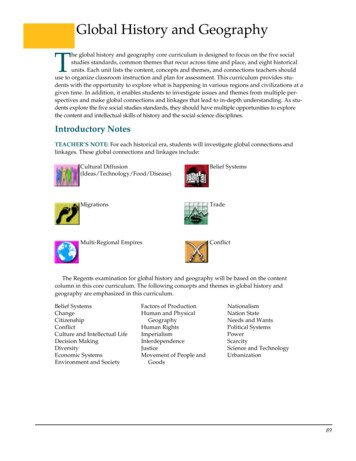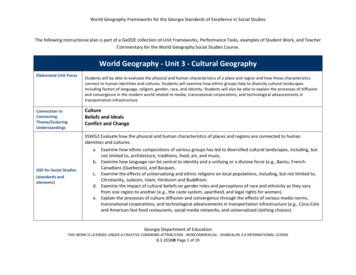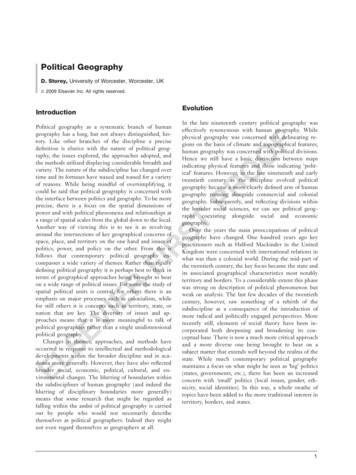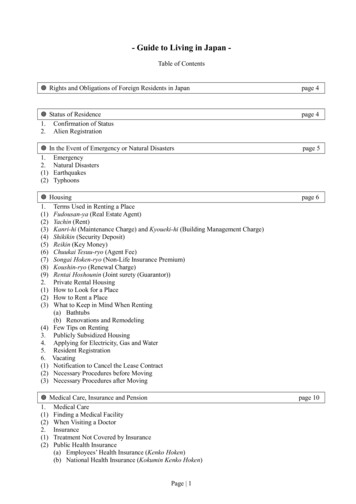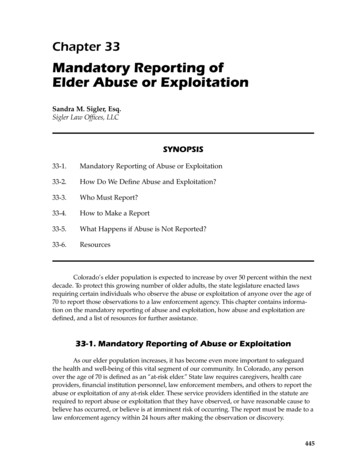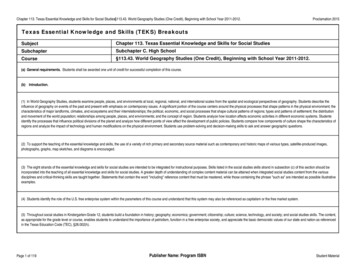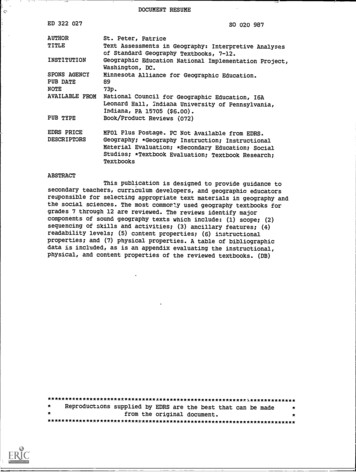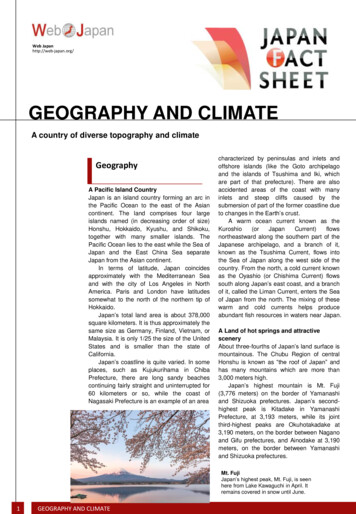
Transcription
Web Japanhttp://web-japan.org/GEOGRAPHY AND CLIMATEA country of diverse topography and climateGeographyA Pacific Island CountryJapan is an island country forming an arc inthe Pacific Ocean to the east of the Asiancontinent. The land comprises four largeislands named (in decreasing order of size)Honshu, Hokkaido, Kyushu, and Shikoku,together with many smaller islands. ThePacific Ocean lies to the east while the Sea ofJapan and the East China Sea separateJapan from the Asian continent.In terms of latitude, Japan coincidesapproximately with the Mediterranean Seaand with the city of Los Angeles in NorthAmerica. Paris and London have latitudessomewhat to the north of the northern tip ofHokkaido.Japan’s total land area is about 378,000square kilometers. It is thus approximately thesame size as Germany, Finland, Vietnam, orMalaysia. It is only 1/25 the size of the UnitedStates and is smaller than the state ofCalifornia.Japan’s coastline is quite varied. In someplaces, such as Kujukurihama in ChibaPrefecture, there are long sandy beachescontinuing fairly straight and uninterrupted for60 kilometers or so, while the coast ofNagasaki Prefecture is an example of an areacharacterized by peninsulas and inlets andoffshore islands (like the Goto archipelagoand the islands of Tsushima and Iki, whichare part of that prefecture). There are alsoaccidented areas of the coast with manyinlets and steep cliffs caused by thesubmersion of part of the former coastline dueto changes in the Earth’s crust.A warm ocean current known as theKuroshio(orJapanCurrent)flowsnortheastward along the southern part of theJapanese archipelago, and a branch of it,known as the Tsushima Current, flows intothe Sea of Japan along the west side of thecountry. From the north, a cold current knownas the Oyashio (or Chishima Current) flowssouth along Japan’s east coast, and a branchof it, called the Liman Current, enters the Seaof Japan from the north. The mixing of thesewarm and cold currents helps produceabundant fish resources in waters near Japan.A Land of hot springs and attractivesceneryAbout three-fourths of Japan’s land surface ismountainous. The Chubu Region of centralHonshu is known as “the roof of Japan” andhas many mountains which are more than3,000 meters high.Japan’s highest mountain is Mt. Fuji(3,776 meters) on the border of Yamanashiand Shizuoka prefectures. Japan’s secondhighest peak is Kitadake in YamanashiPrefecture, at 3,193 meters, while its jointthird-highest peaks are Okuhotakadake at3,190 meters, on the border between Naganoand Gifu prefectures, and Ainodake at 3,190meters, on the border between Yamanashiand Shizuoka prefectures.Mt. FujiJapan’s highest peak, Mt. Fuji, is seenhere from Lake Kawaguchi in April. Itremains covered in snow until June.1GEOGRAPHY AND CLIMATE
As it is situated along the circum-Pacificvolcanic belt, Japan has several volcanicregions—usually considered to number seven—from the far north to the far south. Of thetotal number of volcanoes, approximately 110are active, including Mt. Mihara on IzuOshima island, Mt. Asama on the borderbetween Nagano and Gunma Prefectures,and Mt. Aso in Kumamoto Prefecture. Japanhas almost 1/10 of the world’s approximately1,500 active volcanoes, even though it hasonly about l/400 of the world’s land area.Though volcanoes can cause great harmthrough large eruptions, they also contributean incalculable tourist resource. Touristicareas such as Nikko, Hakone, and the IzuPeninsula, for example, are famous for theirhot springs and attractive scenery of volcanicmountains.As all these volcanoes attest, the Earth’scrust beneath the Japanese archipelago isunstable and full of energy. Thus Japan isamong those countries most likely to sufferfrom earthquakes. Every year there areapproximately 1,000 earthquakes which arestrong enough to be felt. In January 1995, theGreat Hanshin-Awaji Earthquake killed over6,000 people, injured over 40,000, and left200,000 homeless. An earthquake in NiigataPrefecture in October 2004 left over 60people dead and more than 4,800 injured. InMarch 2011, a magnitude 9 earthquake wasrecorded off the coast of Sanriku (Tohoku) inthe Pacific Ocean, and the ensuing tsunami,about 10m high in places, hit the coast acrossa vast region from Tohoku to Kanto. Thenumber of dead and missing after theearthquake and tsunami reached nearly18,000.Fast-Flowing RiversMountainous Japan is blessed with manyrivers. Most of Japan’s rivers flow very fast,their waters reaching the ocean not long afterleaving mountain valleys and basins. Anexample of the “steepness” of river flows isthe Kurobe River, which joins the Sea ofJapan after flowing about 85 kilometers fromits source in the Japan Alps at an altitude ofover 2,900 meters.Japan’s longest river is the Shinano River,which flows 367 kilometers from themountains of the Chubu region throughNiigata Prefecture to the Sea of Japan.2GEOGRAPHY AND CLIMATESecond in length is the Tone River, whichflows through the Kanto Plain to the PacificOcean, and third in length is the Ishikari Riverin Hokkaido, at about 268 kilometers.The many rivers descending frommountainous areas have done much to moldJapan’s topography, creating large and smallvalleys and basins and producing fan-shapeddeltas near the points where they flow into thesea. Most of the country’s plains are small.The largest is the Kanto Plain, which includesparts of Tochigi, Ibaraki, Gunma, Saitama,Chiba, Tokyo, and Kanagawa prefectures.Other relatively large areas of flat land are theEchigo Plain (Niigata Prefecture), the IshikariPlain (Hokkaido), and the Nobi Plain (Aichiand Gifu prefectures).ClimateA major feature of Japan’s climate is theclear-cut temperature changes between thefour seasons. From north to south, Japancovers a range of latitude of some 25 degreesand is influenced in the winter by seasonalwinds blowing from Siberia and in thesummer by seasonal winds blowing from thePacific Ocean. In spite of its rather small area,Japan is characterized by four differentclimatic patterns.Hokkaido, with a subarctic weatherpattern, has a yearly average temperature of9.45 degrees centigrade and receives anaverage annual precipitation of about 1,205millimeters. The Pacific Ocean side of Japan,from the Tohoku region of northern Honshu toKyushu, belongs to the temperate zone, andits summers are hot, influenced by seasonalwinds from the Pacific. The side of thecountry which faces the Sea of Japan has a
Himeji Castle in springCherry blossoms are the symbol ofspring in Japan.climate with much rain and snow, produced whencold, moisture-bearing seasonal winds from thecontinent are stopped in their advance by theCentral Alps and other mountains which run alongJapan’s center like a backbone. The southwesternislands of Okinawa Prefecture belong to thesubtropical climate zone and have a yearly averagetemperate of over 22 degrees, while receiving over2,000 millimeters of precipitation.Spring (March, April, May)When winter nears its end, the cold seasonal windsblowing from the continent become weaker andmore intermittent. At this time, low pressure airmasses originating in China enter the Sea of Japan;these give rise to strong, warm southerly windswhich travel toward this low-pressure zone from thePacific Ocean. The first of these winds is called haruichiban. While it announces the warmth of thecoming spring, it sometimes causes avalanches and,crossing the mountains to the side of the countryfacing the Sea of Japan, it is at times responsible forexceptionally hot and dry weather and can evenbecome the cause of large fires.In early spring, plum blossoms start to bloom,followed by peach blossoms. Between late Marchand the end of April, the cherry blossoms sobeloved by the Japanese people begin to bloom,starting in southern Japan and slowly spreadingnorth.Summer (June, July, August)Before the arrival of real summerlike weather, Japanhas a damp rainy season known as tsuyu. FromMay until July, there is a high- pressure mass ofcold air above the Sea of Okhotsk to the north ofJapan, while over the Pacific Ocean there developsa high-pressure mass of warm, moist air. Along theline where these cold and warm air masses meet,known as the baiu zensen, or “rainy season front,”there often develop areas of low-pressure warm air.Thus the baiu zensen, which extends from southernChina over the Japanese archipelago, causesprolonged periods of continuous rainfall.After the middle of July, high-pressure airmasses over the Pacific Ocean becomepredominant and the rainy season comes to an endas the baiu zensen is pushed northward. Seasonalwinds from the Pacific Ocean bring warm, moist airto Japan, and the country has hot summer weatherwith many days when temperatures rise to morethan 30 degrees centigrade.3GEOGRAPHY AND CLIMATEAutumn (September, October, November)From the end of summer through September, Japanis often struck by typhoons. Typhoons originate fromlarge masses of tropical low-pressure air in theNorth Pacific between the latitudes of approximately5 and 20 degrees, and are the same phenomenonas hurricanes and cyclones in other parts of theworld. When a typhoon begins to take shape, itgradually moves north. Every year, during thisperiod, around 25 typhoons form, of which on theaverage about 4 reach Japan, sometimes causinggreat destruction.After the middle or latter part of October, Japanenjoys generally clear weather; it is neither hot norcold. The country also enjoys especially fineweather at the beginning of November. Many of thetrees take on bright autumn colors, making this timeof the year, together with the time of new greeneryin the spring, a truly beautiful season.Autumn scenery at the Kegon falls and LakeChuzenjiColorful foliage is the symbol of autumn throughoutJapan.Winter (December, January, February)Toward the end of November, cold seasonal windsbegin blowing over Japan from the continent. Thesenorthwesterly winds pick up moisture over the Seaof Japan and drop much of this moisture in the formof rain and snow on the western side of Japan asthey are impeded in their eastern advance by theridge of mountains that runs through the central partof the country. The Hokurikuregion (Fukui,Ishikawa, Toyama, and Niigata prefectures),
which faces the Sea of Japan and isseparated from other regions of Japan byhigh mountains, is known for its deep snows.By contrast, the Pacific side of the countryenjoys generally clear skies during the winterseason. In Tokyo, despite the fair skies,winter temperatures average around 5degrees, a difference of 25 degrees fromsummer temperatures of 30 degrees or more.The islands of Okinawa Prefecture in thefar southwest have a subtropical climate withless marked temperature differences betweenthe seasons. Winter temperatures there aremuch more moderate than in other parts ofthe country.Shirakawa-go in WinterThe gassho-zukuri style farmhouses of Shirakawavillage in Gifu Prefecture were inscribed on theUNESCO World Heritage List in 1995. (Photocourtesy of AFLO)4GEOGRAPHY AND CLIMATE
5GEOGRAPHY AND CLIMATE
the Sea of Japan along the west side of the country. From the north, a cold current known as the Oyashio (or Chishima Current) flows south along Japan’seast coast, and a branch of it, called the Liman Current, enters the Sea of Japan from the north. The mixing of these warm and cold cur
